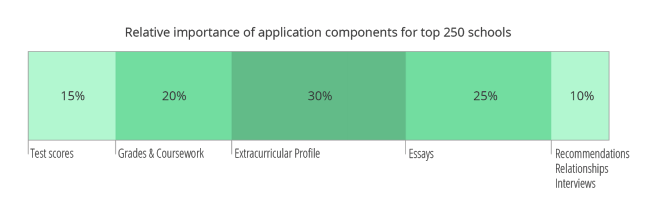Top 10 Hardest Colleges to Get Into
As the number of students pursuing higher education continues to rise, gaining admission to college is becoming more competitive than ever. In particular, the nation’s best schools have especially rigorous standards, accepting only a handful of the students who apply on a yearly basis. Still, getting into an Ivy League or prestigious college comes with numerous advantages. Along with the opportunity to earn a world-class education, students at top schools enjoy access to a well-connected alumni network and the potential for greater earnings — in fact, an Atlantic article reveals that women who attend schools with an 100-point higher average SAT score make over 14 percent more money than their peers. If you’re hoping to attend a top school, keep reading to learn about the hardest colleges to get into and discover what they’re looking for in applicants. Students sometimes make the mistake of assuming that Ivy League schools come with the most rigorous admissions standards. While gaining acceptance to one of these venerable institutions is no easy feat, some of the hardest colleges to get into don’t bear the illustrious “Ivy” label. The following list is all based on data from 2019, unless otherwise noted. The most selective schools in the nation have their pick of applicants. Fortunately, there are steps you can take to help your admissions profile stand out from the crowd. Below are some tips to increase your odds at the hardest colleges to get into. You probably know that academic factors like grades and test scores play a crucial role in admissions decisions at selective schools. However, you might not realize that many top colleges use something called the Academic Index (AI) to assess applicants. AI enables schools to compare students based on a single numerical score, and some schools use it as a screening tool–those with AIs below a certain threshold may even get automatically rejected. How is AI generally calculated? To start, schools compile three separate numbers based on a student’s GPA/class rank, standardized test scores, and SAT Subject test scores, assuming the college accepts them. These values range from 20-80, with 80 being the highest possible score. The admissions committee then adds the separate values for a total possible index score of 240. The idea of reducing students to a single number might sound harsh. However, this process helps explain why students need to work hard to ensure their grades and test scores are as strong as possible before applying to top schools. Stellar academics won’t get you an automatic acceptance, but it will at least get your foot in the door. On the flip side, lackluster academics could keep you out entirely. Of course, academics aren’t the only crucial factor in college admissions. After all, many of the students who apply to schools like Harvard are valedictorians and salutatorians with stellar test scores. To find the most desirable applicants, top colleges have to look beyond grades to factors like extracurriculars. In fact, at the top 250 schools, extracurriculars account for around 35% of your application, the same weight as grades and test scores combined. While having activities outside the classroom is undeniably important, it’s a mistake to think all extracurriculars are created equal. The hardest colleges to get into give more weight to certain extracurriculars than others. At CollegeVine, we divide activities into four tiers to help students assess where their profiles fall. The first tier is the most impressive in the eyes of admissions committees, with the fourth being the least exceptional. Here are some of the characteristics used to distinguish among the four tiers of extracurriculars: Tier 1 – The top class of extracurriculars, Tier 1 activities showcase a superior level of excellence that is rare and difficult to achieve. These accomplishments include becoming a nationally ranked athlete or attending a prestigious summer program. Tier 2 – The next most impressive extracurricular grouping,Tier 2 refers to slightly more common achievements that are still highly admirable. For example, the #5 tennis player in the state, the study body president, or cellist in all-state orchestra can boast tier 2 extracurriculars. Tier 3 – While less distinguished than Tiers 1 and 2, Tier 3 activities still demonstrate some leadership and accomplishment. Examples of tier 3 extracurriculars include serving as class treasurer, starring in the school musical, or winning a most valuable player award for your sports team. Tier 4 – The most commonly seen extracurriculars, Tier 4 activities are less likely to turn the heads of admissions officers. That said, these activities are still valuable in that they help showcase a student’s interests and hobbies outside the classroom. These hobbies include playing high school sports, taking guitar lessons, or volunteering your time at a local charity. While the average student resume includes a range of extracurriculars, the most desirable applicants have at least a few tier 1 and tier 2 activities in the mix. The goal is to build a profile that showcases a diverse range of interests united by a common theme. For example, a student who dreams of being a math teacher might want to consider participating in both the math bowl and school tutoring club, using their knowledge to help fellow students improve their grades. College essays offer a valuable opportunity for admissions committees to get to know their applicants and learn what matters to them. While grades and test scores reveal a more objective view of a candidate, the best essays show the personality of a student while demonstrating the qualities and strengths they’ll bring to the campus. The goal is to show not only why the college is ideal for you but why you’re a great fit for the college. To that end, the best essays have a strong hook that draws the reader in from the start. For example, you could start with an anecdote, a vivid description, a question. The goal is to catch the reader’s attention and get them thinking from the first paragraph. Additionally, strong essays tell a compelling story about the applicant’s life. Colleges use essays to evaluate the aspects of a student that can’t be reduced to numbers. Rather than simply listing your grades or achievements, use your essay to discuss an experience that made you into the person you are today. Worried you have nothing interesting to write about? Brainstorm your most meaningful high school experiences, the ones that led you to reflect or pushed you to grow. This could be an extracurricular experience, such as joining debate when you initially were terrified of public speaking. You could describe a personal project, such as building a computer and why you love programming. Don’t be afraid to get vulnerable, either–for instance, you could discuss how your experience with cyberbullying, how you overcame it, and how it led you to want to study social psychology. To learn more about writing a standout college essay, check out our guides for the 2020 Common App Essays and Coalition Application Essays. Just because a school bears the label of “hardest colleges to get into” doesn’t mean you have no chance of gaining acceptance. At CollegeVine, we created our data-driven chancing engine to provide students with accurate insight into their admissions chances at hundreds of schools across the U.S. You can find out which schools you’re most likely to get into and then learn tips for raising your chances of success. Sign up today and start using our chancing engine for free.10 Hardest Colleges to Get Into
Name of School
Location
Acceptance Rate
Middle 50% SAT
Middle 50% ACT
Stanford University
Palo Alto, CA
4.3%
1440-1550
32-35
Harvard University
Cambridge, MA
4.5%
1460-1580
33-35
Columbia University
New York, NY
5.3%
1480-1560
33-35
Princeton University
Princeton, NJ
5.8%
1460-1570
33-35
University of Chicago
Chicago, IL
6.2%
1500-1560
33-35
Yale University
New Haven, CT
6.1%
1470-1560
33-35
California Institute of Technology (Caltech)
Pasadena, CA
6.4%
1530-1570
35-36
MIT
Cambridge, MA
6.7%
1520-1580
34-36
Brown University
Providence, RI
7.1%
1440-1550
32-35
University of Pennsylvania
Philadelphia, PA
7.7%
1460-1550
33-35
How to Improve Your Chances at Selective Schools
1. Make Sure Your Academics Are up to Par
2. Cultivate Standout Extracurriculars

3. Write Engaging Essays
4. Understand Your Chances





